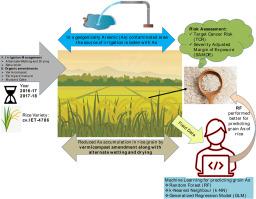Agriculture, Ecosystems & Environment ( IF 6.0 ) Pub Date : 2021-05-28 , DOI: 10.1016/j.agee.2021.107516 Sudip Sengupta , Kallol Bhattacharyya , Jajati Mandal , Parijat Bhattacharya , Sanjay Halder , Arnab Pari

|
Dietary rice consumption can assume a significant pathway of the carcinogenic arsenic (As) in the human system. In search of a viable mitigation strategy, a field experiment was conducted with rice (cv. IET-4786) at geogenically arsenic-contaminated areas (West Bengal, India) for two consecutive years. The research aimed to explore irrigation management (saturation and alternate wetting and drying), and organic amendments (vermicompost, farmyard manure, and mustard cake) efficiencies in reducing As load in the whole soil-plant system. A thrice replicated strip plot design was employed and As content in the soil, plant parts, and the associated soil physicochemical properties were determined through a standard protocol. Results revealed that the most negligible As accumulation in the edible grains was accomplished by vermicompost amendment along with alternate wetting and drying (0.318 mg kg−1) over farmer’s practice of continuous submergence with no manure situation (0.895 mg kg−1). Interestingly, an increase in the grain yield by 25% was also observed. The risk of dietary exposure to As through rice was assessed by target cancer risk (TCR) and severity adjusted margin of exposure (SAMOE) mediated risk thermometer. The adopted strategy made all the risk factors somewhat benign to ensure a better standard of health. The Machine Learning algorithm revealed that Random Forest performed better in predicting grain As concentration than k-Nearest Neighbour and Generalized Regression Model. Hence, if properly calibrated and validated, the former can represent an effective tool for predicting grain As concentration in rice.
中文翻译:

缺水灌溉和有机改良剂可以降低水稻的膳食砷风险:从田间数据中引入基于机器学习的预测模型
膳食大米消费可以假定致癌性砷 (As) 在人体系统中的重要途径。为了寻找可行的缓解策略,连续两年在地质砷污染地区(印度西孟加拉邦)对水稻(cv. IET-4786)进行了田间试验。该研究旨在探索灌溉管理(饱和和交替润湿和干燥)和有机添加物(蚯蚓堆肥、农家肥和芥菜饼)在减少整个土壤植物系统中砷负荷方面的效率。采用三次重复的带状小区设计,并通过标准方案确定土壤、植物部分和相关土壤理化特性中的 As 含量。-1 ) 超过农民在无粪便情况下连续浸没的做法 (0.895 mg kg -1 )。有趣的是,还观察到谷物产量增加了25%。通过目标癌症风险 (TCR) 和严重程度调整的暴露边际 (SAMOE) 介导的风险温度计评估通过大米饮食暴露于砷的风险。所采用的策略使所有风险因素在某种程度上是良性的,以确保更好的健康标准。机器学习算法表明,随机森林在预测颗粒 As 浓度方面的表现优于 k-最近邻和广义回归模型。因此,如果经过适当的校准和验证,前者可以成为预测大米中谷物 As 浓度的有效工具。











































 京公网安备 11010802027423号
京公网安备 11010802027423号